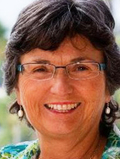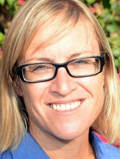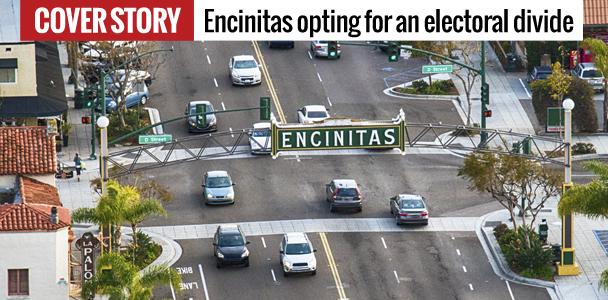Encinitas opting for an electoral divide
City Council votes to split into districts in wake of legal threat from Malibu law firm
Traffic moves along Coast Highway 101 in January 2016 in Encinitas, one of several north San Diego County cities opting for City Council districts in light of recent legal threats. (Photo by Art Wager, iStock Getty Images)
August 31, 2017
Following the receipt of a demand letter from Malibu law firm Shenkman & Hughes, the Encinitas City Council decided unanimously Aug. 30 to move forward with developing a districting process for the City Council election system.

“From my perspective, it would be a waste of money and would cost us at least a million dollars to fight it, and that would be if we won because we would still pay our own attorney fees,” Encinitas Mayor Catherine Blakespear said a few days before the council meeting. “For me, this is not one of our top priorities — this isn’t where we should be spending our money and our time.”
The demand letter sent by Kevin I. Shenkman dated July 14 — on behalf of the Southwest Voter Registration Education Project — claims that voting in Encinitas is “racially polarized, resulting in minority vote dilution” as a result of the current at-large electoral system. The resolution to this problem, Shenkman said, is abiding by the California Voting Rights Act of 2001, which prohibits at-large electoral systems for city councils.
Latinos comprise 13.7 percent of Encinitas’ 63,131 population, U.S. Census Bureau figures show.
In total, Shenkman & Hughes has sent letters to approximately 30-40 cities since 2012, with lawsuits being filed against Palmdale, Santa Clarita, San Juan Capistrano, Rancho Cucamonga, West Covina, Highland Fullerton and Garden Grove. The firm won cases in all eight cities either through judgement or settlement, Shenkman said.
“I’ve seen the deleterious effects of what an at-large election system can have on minority communities,” Shenkman said. “We have seen it where a significant minority community is simply ignored by its local government and really neglected. Oftentimes, we look to the soap opera that is the federal government these days, and while that’s certainly important, the truth is your local government has far more impact on your everyday life than does the federal government.”
After attorney fees have been paid, any money left over from the settlement or court judgement has been donated to voting rights groups such as SVREP to strengthen voting infrastructure and knowledge in each city’s minority community, Shenkman said.
The demand letter sent to Encinitas, however, incorrectly claims that no Latina/o council members have been elected in Encinitas’ history, when in fact there have been two since the city was incorporated in 1986. The first Latina councilwoman, Mary Lou Aspell, served on the City Council for one term from 1994 to 1998, followed by Teresa Arballo Barth, who served for two terms from 2006 to 2014.

Barth said she does not believe that the Encinitas City Council has an ethnic diversity problem and that it fairly represents the community, but she instead feels that until recently there has been an age diversity problem.
“I never felt that the city was in any way discriminatory — they have city employees who are bilingual, we had a city manager who was Hispanic and we had translators at our original housing element workshops and Spanish-speakers at every public workshop to assist as needed,” Barth said. “I see the value of districts in larger cities like San Diego and Oceanside, but for cities like Encinitas, I really don’t think it’s in the best interest for the city.”
Barth added that “in terms of the demand letter saying it would be increasing the opportunity for Hispanics or any other ‘groups of interest,’ I just don’t think that there is a large enough population of Hispanics that you could make it work in a single district because the population is not concentrated as much in any one area that could be defined as a district.”
After more research, public statements and advice from a demographer, the new by-district electoral system would be in place by the end of the year in order to avoid going to court. Most likely, each voter in Encinitas would elect their district representative and the city’s mayor at large.
The development process will continue in open sessions in order to keep the residents of Encinitas involved, Blakespear said.
At its Aug. 30 meeting, however, the council opted to proceed with one closed session at its next meeting Sept. 6 to discuss legal issues involving the process.
“I don’t think it will be ‘better,’ but I don’t think it will be a disaster, either,” Blakespear said of the future by-district electoral system. “I think the City Council is working well under its current system, but I believe there are qualified people in every district who will be able to represent the needs of both the district and the city at large.”
One of the possible issues that Blakespear said she could see arising under the new system would be whether all City Council members would be invited to business openings — as they currently are, for example — or if they would only be invited to and/or attend openings in their districts.
“Right now, there is a greater presence of the elected officials, and I think that those types of things will change because of the nature of what it means to represent a smaller district,” Blakespear said.
Carlsbad sets precedent in local voting structure change
Carlsbad’s City Council recently preceded Encinitas in its own decision to switch to by-district voting after receiving a demand letter from Shenkman & Hughes in May.

According to Cori Schumacher, first-term councilwoman from Carlsbad, every one of the approximately 26 cities that has gone to court for similar Voting Rights Act cases has lost, with a grand total of about $14 million.
“It didn’t seem as though there was a very good case against Carlsbad, but we decided that instead of spending the city’s tax money, that we would switch to by-district voting voluntarily and save ourselves millions of dollars,” Schumacher said. “In voluntarily switching to a by-district voting structure, we would be retaining the community’s right to give input on that, and that was the most important element to the decision.”
In order to keep the voters of Carlsbad involved with the process to switch to the by-district structure, the City Council held two workshops to educate the community about the process. In the end, the City Council chose a map designed by Arnie Cohen and Brian Flock, two Carlsbad residents, in lieu of the maps designed by professional demographers.
As a result of the decision to switch to a by-district election system, Schumacher will face fourth-term Councilman Mark Packard in a re-election next year as they both reside in the same district.
Schumacher said the switch from at-large to by-district councils in Carlsbad and Encinitas will likely have different effects in the two cities since Carlsbad has 114,000 residents versus Encinitas’ 63,000. She added that there could be potential positive and negative consequences of the new by-district voting structure.
“You may get elected officials that are only going to be paying attention to their district issues, and that could potentially create a situation where you have vote trading and less of a concern for the entire citywide policies,” Schumacher said. “On the positive side of things, you have the opportunity to re-enfranchise (sic) populations who may have their voices diluted, whether that is a coastal community of interest that is impacted by development — those folks could have the opportunity to weigh in where they were ignored before.
“That also applies to Latinos in the district — for us (Carlsbad), we went from 13 percent citywide to 22 percent of the voter population in the district being Latino.”
The key in governing in a by-district electoral system will be good communication streams between elected officials and their constituents, Schumacher added.
Lauren J. Mapp is a San Diego freelance writer. North Coast Current Editorial Director Roman S. Koenig contributed to this report.





